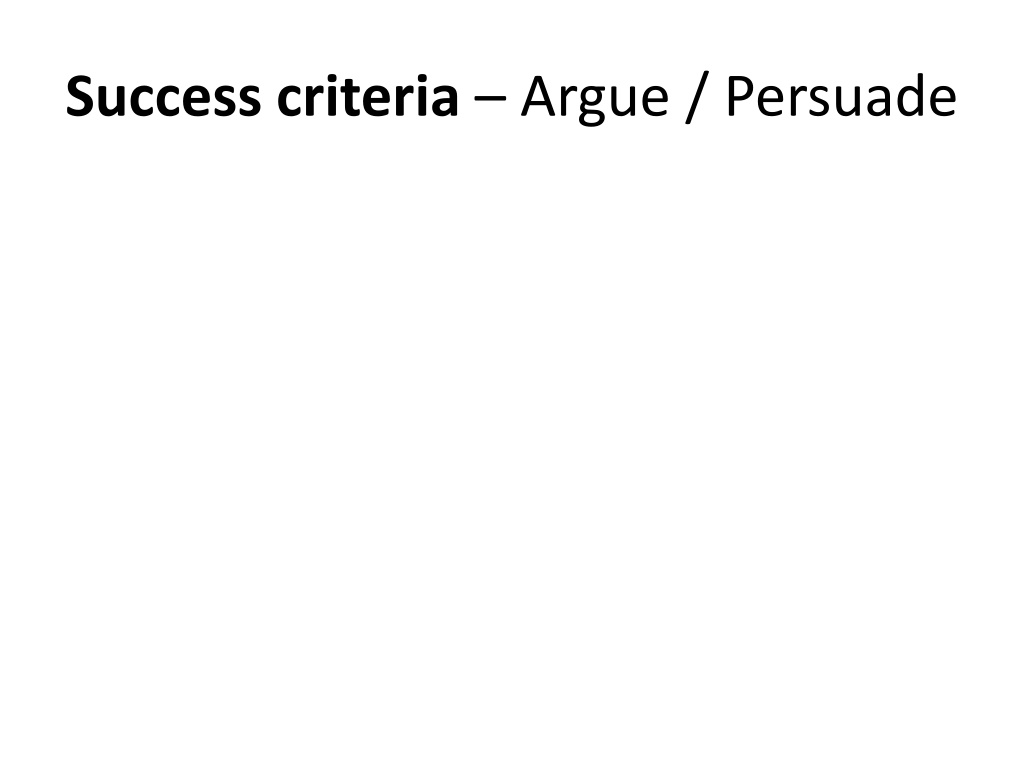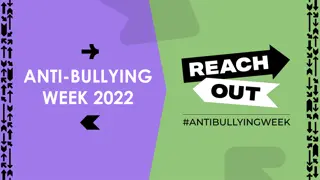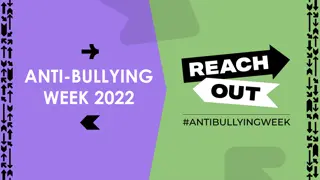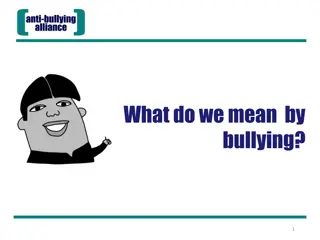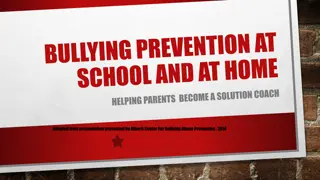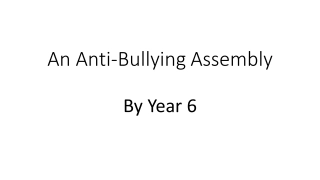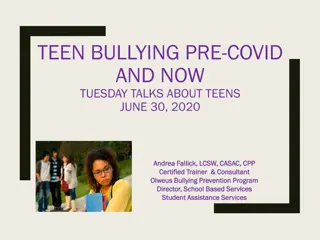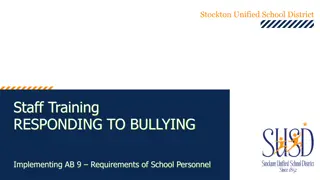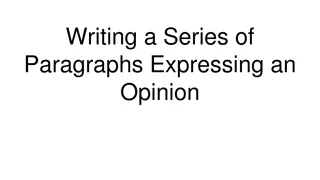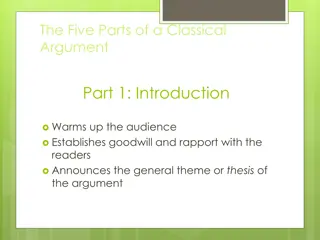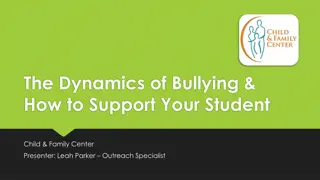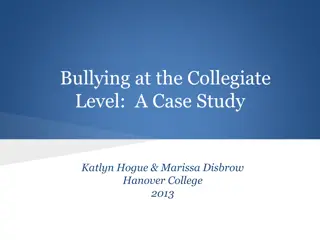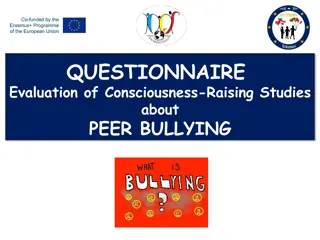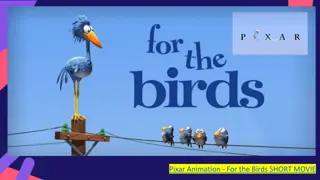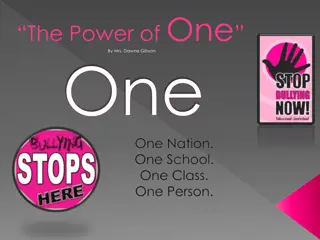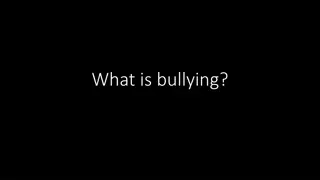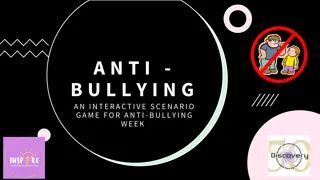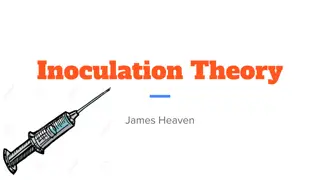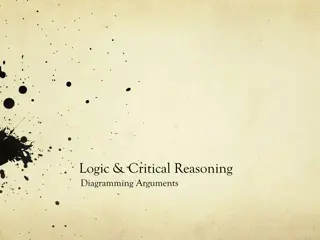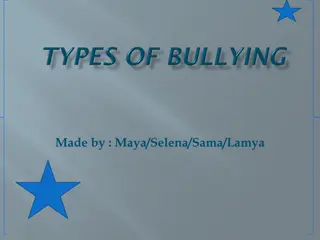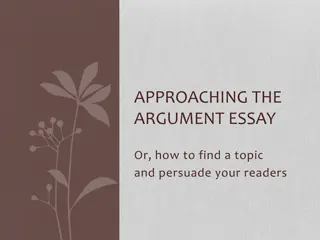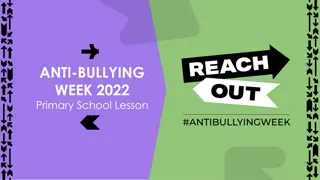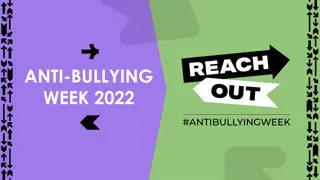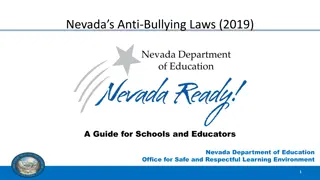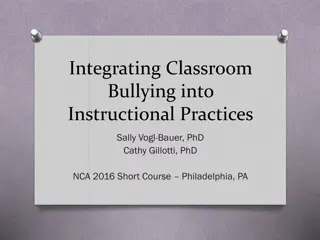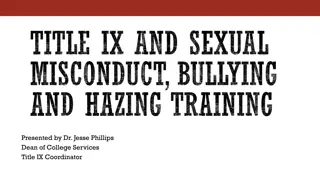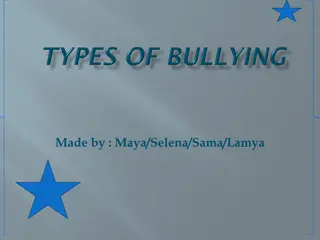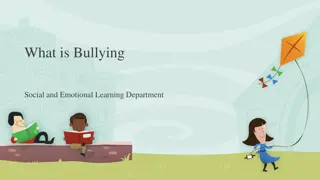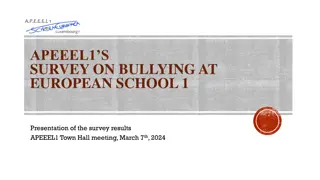Combatting Bullying in Schools: A Persuasive Argument for Change
Discussing the damaging effects of bullying in schools, this article presents a compelling argument against this behavior. Highlighting the need for action, it delves into the emotional impact on students, emphasizing the urgency of addressing bullying in educational settings.
Download Presentation

Please find below an Image/Link to download the presentation.
The content on the website is provided AS IS for your information and personal use only. It may not be sold, licensed, or shared on other websites without obtaining consent from the author. Download presentation by click this link. If you encounter any issues during the download, it is possible that the publisher has removed the file from their server.
E N D
Presentation Transcript
The very first sentence should shock or surprise the reader, hooking them in. Use an interesting sentence type Use a powerful technique like imperatives Use a very short sentence Say something shocking / surprising / strange ver Example (Piece about dangers to young people): Young people are going to die. -5
Short topic paragraph at the start explaining what you are writing about, and what your opinion about this is I wanted to write this article to discuss my feelings about bullying in today s schools, in particular the awful damage that it does. My overall opinion here will be that bullying is -5
Counterargument: If your question requires you to discuss whether or not you agree with something, make sure you discuss the other point of view to your own in the middle of your article, saying why you disagree with this -5 1) Start off with a change of direction connective (on the other hand), 2) Say clearly that these are not your opinions (Some people might think that, Others might argue), 3) Say why you do not agree with them(I disagree with this because, This is not correct because)
Connectives: Use a variety of connectives to join your ideas together. Always use a comma after a connective: In addition, -5 1) Connectives to order your ideas (First, Next, Secondly etc.,) 2) Connectives to add similar ideas (In addition, Also, Furthermore) 3) Connectives to show a change in direction (However, On the other hand, Alternatively) 4) Connectives to show your most important ideas (Above all, In particular, Most importantly)
Use short, simple sentences to provide contrast with longer sentences and add emphasis The more I think about the bullying issue in schools, the angrier I get. I, and many other students in school, have had enough of the cruel, sadistic and ignorant bullies. It is simply not good enough. -5
Every time you discuss a new idea, you must support this with at least one of the following techniques: An anecdote to provide evidence for your point of view Some statistics to demonstrate the power of your idea An expert opinion to show why it is a good idea. Two strong arguments as to why your view is correct. -5
Personal Pronouns: Words which refer to people: you we I We should fight for our right to go to Mars. Do you agree? Combine with a sentence type! 1
Opinions of Experts: A quote from a reliable person on the subject. Professor J. Goodrich has stated that children are more likely to become successful adults if, and only if, they are happy at school. 1 Combine with a sentence type!
Statistics: Using numbers to support your argument. It would increase our economy by 25%, with 1 in 3 people benefitting. Combine with a sentence type! 1
Triplet: Three powerful words or phrases on the same topic. I am head and shoulders more attractive, more intelligent and more adaptable than the other candidates. Combine with a sentence type! 1
Anecdote: A short personal story about the topic. When I was a student, my experience of school was clouded by bullies. I remember particularly .. Combine with a sentence type! 1
Imperatives: Language that commands the reader. Do something about it. The next time you are faced by bullies, act and make sure they never harm anyone else. Whatever you do, don t just do nothing. Combine with a sentence type! 1
Comma sandwich : a sentence with an embedded clause (which is surrounded by commas). The sun, which had been absent for days, shone steadily in the sky. 2
The more, more, more sentence The more he worried, the more he felt uncomfortable, the more he wanted to leave the room. 3
The less, less, less sentence The less I tried, the less I cared, the less I got. 3
Comparative (-er), more, more sentence Every day, Kitty felt smaller, more ugly, more useless. 4
Sentences with a semi-colon in the middle to connect two clauses. Spider-Man was in trouble; he was surrounded by his enemies. 2
Colons to clarify A strange hint of something filled his nostrils and made his stomach lurch: it was blood. 2
Not, nor, nor sentences Nobody, not the postman, nor the housekeeper, nor Jim himself knew how the letter had got onto the doormat. 3
Fortunately / Unfortunately paired sentences Unfortunately, the door was locked. Fortunately, there was a catflap just big enough for him to fit through. 3
The writers aside sentence The computer, as you know, is quite slow. I think, to be honest, it will never work. 2
Verb -ed opening Wracked with fear, Tommy crept slowly towards the door. Scared for her life, Anna searched frantically for the key. 1
x wasnt/isnt the word Disgusting wasn t the word. There were no words to describe what lay before her. Riveting just isn t the word. There s nothing to say that can do this thing justice. 4
Not only but also sentence Not only was he cold, hungry and tired, but the chance of him being discovered would also increase. 2
It was semi colon it was sentence It was the best of times; it was the worst of times. 3
-ing clause before the main sentence Having no choice about it, Chris decided to agree with her. 1
Second Conditional Sentence: Its still possible If I were to...... If I were to win the lottery, I would buy a Lamborghini Gallardo. 2
Third Conditional Sentence : Also known as the Too late sentence If I had..... I would have..... If I had left the house earlier, I would have been on time for registration 3
Three adjectives at the start sentence Ruthless, dangerous, lethal, the animal leaps for its prey. 2
Repeat and develop ideas sentence The teacher s decision to set double homework was both surprising and distressing - surprising in that she had never set homework before, distressing in that it was to be completed in one day. 4
Using dashes instead of brackets sentence The roof - the straw thatch - was gone. 1
you / we / some / our You have probably have never voted before. We have heard so much about politicians and their claiming of expenses. Some even think they have a right to steal from the taxpayer. Our hard-earned money is being wasted to fund a politician s birdbath. 2
Many Questions -This sentence type usually begins with a question beginning with either: Who? What? Where? When? Why? How? or What if? This is then followed by further short questions. How dare they do this to us? Can we let them get away with this? Why should they be allowed? What can we even do? 2
Some; Others - The first part of this sentence begins with the word some. The second part of the sentence is separated with a semi colon and the word others. Some children walk to school; others travel by car. 3
Two Pair -This sentence begins with two pairs of related adjectives, followed by a comma. Tired and hungry, confused and exhausted, I got home in need of a refreshing drink. 3
